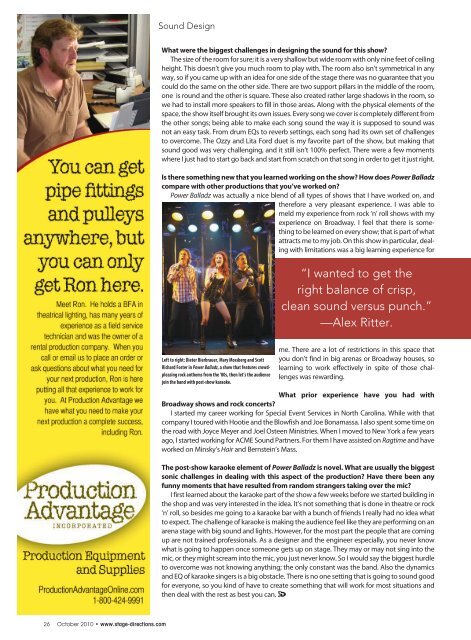Download a PDF - Stage Directions Magazine
Download a PDF - Stage Directions Magazine
Download a PDF - Stage Directions Magazine
You also want an ePaper? Increase the reach of your titles
YUMPU automatically turns print PDFs into web optimized ePapers that Google loves.
Sound Design<br />
What were the biggest challenges in designing the sound for this show?<br />
The size of the room for sure; it is a very shallow but wide room with only nine feet of ceiling<br />
height. This doesn’t give you much room to play with. The room also isn’t symmetrical in any<br />
way, so if you came up with an idea for one side of the stage there was no guarantee that you<br />
could do the same on the other side. There are two support pillars in the middle of the room,<br />
one is round and the other is square. These also created rather large shadows in the room, so<br />
we had to install more speakers to fill in those areas. Along with the physical elements of the<br />
space, the show itself brought its own issues. Every song we cover is completely different from<br />
the other songs; being able to make each song sound the way it is supposed to sound was<br />
not an easy task. From drum EQs to reverb settings, each song had its own set of challenges<br />
to overcome. The Ozzy and Lita Ford duet is my favorite part of the show, but making that<br />
sound good was very challenging, and it still isn’t 100% perfect. There were a few moments<br />
where I just had to start go back and start from scratch on that song in order to get it just right.<br />
Is there something new that you learned working on the show? How does Power Balladz<br />
compare with other productions that you’ve worked on?<br />
Power Balladz was actually a nice blend of all types of shows that I have worked on, and<br />
therefore a very pleasant experience. I was able to<br />
meld my experience from rock ‘n’ roll shows with my<br />
experience on Broadway. I feel that there is something<br />
to be learned on every show; that is part of what<br />
attracts me to my job. On this show in particular, dealing<br />
with limitations was a big learning experience for<br />
“I wanted to get the<br />
right balance of crisp,<br />
clean sound versus punch.”<br />
—Alex Ritter.<br />
Left to right: Dieter Bierbrauer, Mary Mossberg and Scott<br />
Richard Foster in Power Balladz, a show that features crowdpleasing<br />
rock anthems from the ‘80s, then let’s the audience<br />
join the band with post-show karaoke.<br />
me. There are a lot of restrictions in this space that<br />
you don’t find in big arenas or Broadway houses, so<br />
learning to work effectively in spite of those challenges<br />
was rewarding.<br />
What prior experience have you had with<br />
Broadway shows and rock concerts?<br />
I started my career working for Special Event Services in North Carolina. While with that<br />
company I toured with Hootie and the Blowfish and Joe Bonamassa. I also spent some time on<br />
the road with Joyce Meyer and Joel Osteen Ministries. When I moved to New York a few years<br />
ago, I started working for ACME Sound Partners. For them I have assisted on Ragtime and have<br />
worked on Minsky’s Hair and Bernstein’s Mass.<br />
The post-show karaoke element of Power Balladz is novel. What are usually the biggest<br />
sonic challenges in dealing with this aspect of the production? Have there been any<br />
funny moments that have resulted from random strangers taking over the mic?<br />
I first learned about the karaoke part of the show a few weeks before we started building in<br />
the shop and was very interested in the idea. It’s not something that is done in theatre or rock<br />
‘n’ roll, so besides me going to a karaoke bar with a bunch of friends I really had no idea what<br />
to expect. The challenge of karaoke is making the audience feel like they are performing on an<br />
arena stage with big sound and lights. However, for the most part the people that are coming<br />
up are not trained professionals. As a designer and the engineer especially, you never know<br />
what is going to happen once someone gets up on stage. They may or may not sing into the<br />
mic, or they might scream into the mic, you just never know. So I would say the biggest hurdle<br />
to overcome was not knowing anything; the only constant was the band. Also the dynamics<br />
and EQ of karaoke singers is a big obstacle. There is no one setting that is going to sound good<br />
for everyone, so you kind of have to create something that will work for most situations and<br />
then deal with the rest as best you can.<br />
26 October 2010 • www.stage-directions.com

















